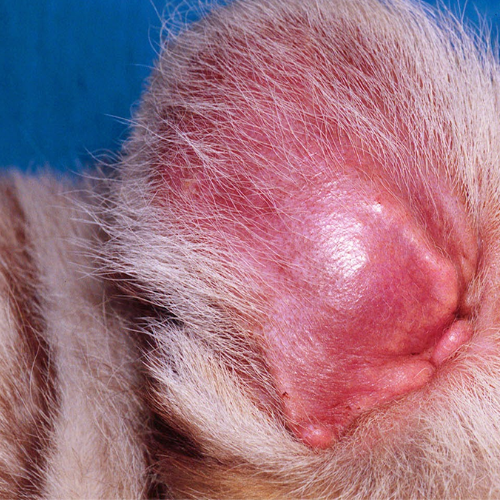Ferret cauliflower ear can be quite problematic, the main thing you should remember is to keep your ferret clean. Have you heard people say that ferrets have a skunky odor? It depends on how frequently you clean your ferret. The steps to properly clean a ferret’s ears are outlined in this easy-to-follow article.
It is recommended that you wipe the ears of your pet ferret as soon as possible after you have finished bathing him. Also, ensure you don’t give your ferret more than one bath a month. The less you bathe your ferret, the less you have to worry about ferret odor.

What Is Cauliflower Ear?
You may have observed certain athletes’ ears if you’ve seen a wrestling match. The condition is known as “cauliflower ear,” which can also be referred to as “wrestler’s ear,” is a malformation of the ear that is brought on by trauma.
Cauliflower ear arises when blood accumulates in a hit pinna. This blood pool, known as a hematoma, requires immediate treatment.
Cauliflower ear is a condition that cannot be treated, but its development can be avoided even after the initial trauma has taken place.
What Causes Ferret Cauliflower Ear?
The ferret ear is susceptible to damage from sudden impact. When the ear is hit, and a blood clot forms under the skin or the skin is ripped off the cartilage, cauliflower ear results.
There is no other source of blood flow to the cartilage of the ferret’s ear other than what is given by the skin that covers it. When the skin is pushed away from the cartilage or when blood separates the skin from the cartilage, the cartilage is devoid of vital nutrients. Ultimately, the cartilage will die, and the chance of getting an infection will increase.

Untreated, the ferret’s ear cartilage shrinks inward, resulting in the cauliflower ear deformity, characterized by a shriveled outer ear. In most cases, the deformity resulting from cartilage death and scar tissue (fibrosis) formation is permanent. As a result of the diminished blood supply, the ferret’s ear may appear pale.
Treatment
Initial Treatment
Apply ice to the injury in the ferret’s ear as soon as possible. You can accomplish this by applying ice to the affected area at regular intervals of 15 minutes. That will assist in lowering the swelling and may prevent cauliflower ear from developing. In addition to that, you should get medical attention straight away.
Drainage and Compression
Your veterinarian might treat the issue by having them drain the extra blood from your ferret’s ear. They cut through the injured site to remove blood.
Your vet will insert a drainage tube into your ferret ear and then prescribe medications to help avoid infection.
Even after the cauliflower ear has been drained, it is critical to keep an eye on your ferret ear for signs of swelling to ensure that it does not return.
- Apple Cider Vinegar for Fleas on Ferrets
- Are Ferrets Affectionate? How Do Ferrets Show Affection?
- Ferret Memory Span – UPDATED 2022 – How Smart Are Ferrets?
Surgery
In certain situations, corrective surgery called otoplasty can reverse the appearance of cauliflower ears.
In surgery, your doctor cuts behind your ferret ear to expose the cartilage. The vet will remove some cartilage or use sutures to remodel the ear. The procedure may need general anesthesia, but in certain instances, it may only be necessary to utilize a local anesthetic.
How to Clean a Ferret’s Ears
After giving your ferret a relaxing bath, rinse it off and pat it dry. The presence of wax in your ferret’s ears is quite natural. The hue of the wax might range from orange to yellowish orange. On the other hand, if you observe a darker coating of ear wax on your ferret’s ears, this may indicate that your ferret has an ear infection.
Ferrets can get ear infections. If you give your ferret the best possible care, he will rarely suffer from an ear infection. You may begin cleaning your ferret’s ears as soon as you determine that there is nothing unusual about the ear wax he produces. To properly clean your ferret’s ears, proceed as outlined in the previous step:
Warm up the Ear Cleanser
It is necessary to preheat the ear cleaner before you begin to scruff the ferret to clean it. There is a possibility that your ferret’s ears will react negatively to cold cleaner.
Put some warm water in a basin, and then immerse the bottle of cleaner in it. Wait for the cleaner to reach your ferret’s body temperature, which should take a minute to two minutes. When you clean his ears, try to make it as comfortable an experience for him as you can.
Use Cotton Swabs
As soon as the cleaner reaches the appropriate temperature, which should be approximately 101 degrees Fahrenheit, near the temperature of your ferret’s body. You can use a cotton swab to wipe his ears. You can also use a cotton swab and two drops of the solution to treat his ears.
You must exercise extreme caution while inserting the cotton swab into your ferret’s ears at this time. You do not want to go in too far and cause damage to his eardrums by doing so. This might result in terrible infections and difficulties with the ear.
While driving in the cotton swabs, you should keep him under control by holding him. For each ear, you will require around five cotton swabs.
Precautions to Take When Cleaning a Ferret’s Ears
Your ferret’s ears are very sensitive portions of their bodies. You need to exercise extreme caution when cleaning his ears, mainly because you will be using a cotton swab. It is easy for it to slide and cause harm to his eardrums.
- Never use alcohol as an ear cleaner. It is sound knowledge that alcohol is an effective antiseptic and cleansing agent for wounds and other types of skin damage. On the other hand, your ferret’s ears will get irritated and dry up as a result of this. Mild ear cleaners should be used on ferrets. Try kitten shampoo if you can’t find one at the pet store.
- Avoid using natural oils for cleaning purposes at all costs. Even though they might appear to be more mild and effective cleaners, using them will cause his ear wax to collect more quickly. Again, you should only use specially formulated cleaners for ferret ears or mild cleaners designed for kittens.
- Don’t use cold ear cleanser. It will make your ferret uncomfortable, and it will be impossible for you to clean his ears.
- Ask for help while washing your ferret. It’s easy to scruff him, but you can’t wipe his ears with one hand. A buddy will help you clean your ferret safely and efficiently.
- After bathing, clean your ferret’s ears. It’s easy, and you just need to clean his ears once a month, like a bath. This will assist in removing any water and shampoo that may have gotten into your ferret’s ears.
- Look for signs of disease. Your ferret seldom gets sick. There is still a possibility that they may become infected with the virus.

Doctor of Veterinary Medicine (D.V.M.) at Nation Taiwan University,Master of Science (M.S.) in Biomedical Engineering at National Taiwan University of Science and Technology




